Tired of manually sending emails, posting on social media, and nurturing leads? Marketing automation is the solution, but seeing it in action is the best way to understand its power. This article moves beyond theory to provide a deep dive into practical marketing automation examples from leading platforms. We will dissect real-world workflows, showing you exactly how businesses use automation to save time, increase efficiency, and drive revenue.
Instead of just telling you what automation can do, we’ll show you. Each example includes a strategic breakdown, tactical insights, and actionable takeaways you can apply to your own campaigns. Whether you're an email marketer, a sales professional, or a social media manager, you'll find replicable strategies tailored to specific channels. We'll explore workflows from industry giants like HubSpot, Mailchimp, and ActiveCampaign, providing screenshots and direct links to see the tools in action.
Our goal is to help you find the right inspiration and platform for your needs. We'll analyze everything from simple welcome sequences to complex, multi-channel customer journeys. By understanding these proven blueprints, you can build more effective campaigns and streamline your operations. For a deeper dive into the strategic advantages, explore the benefits and use cases of enterprise workflow automation. Let's explore the examples.
1. OKZest
OKZest presents a powerful and highly specific marketing automation example focused on a single, high-impact channel: visual personalization. It automates the creation of unique, dynamic images for individual recipients, effectively acting as "merge tags for images." This no-code platform allows marketers to move beyond generic stock photos and text-based personalization, capturing attention in crowded inboxes and social media feeds where engagement is decided in seconds.
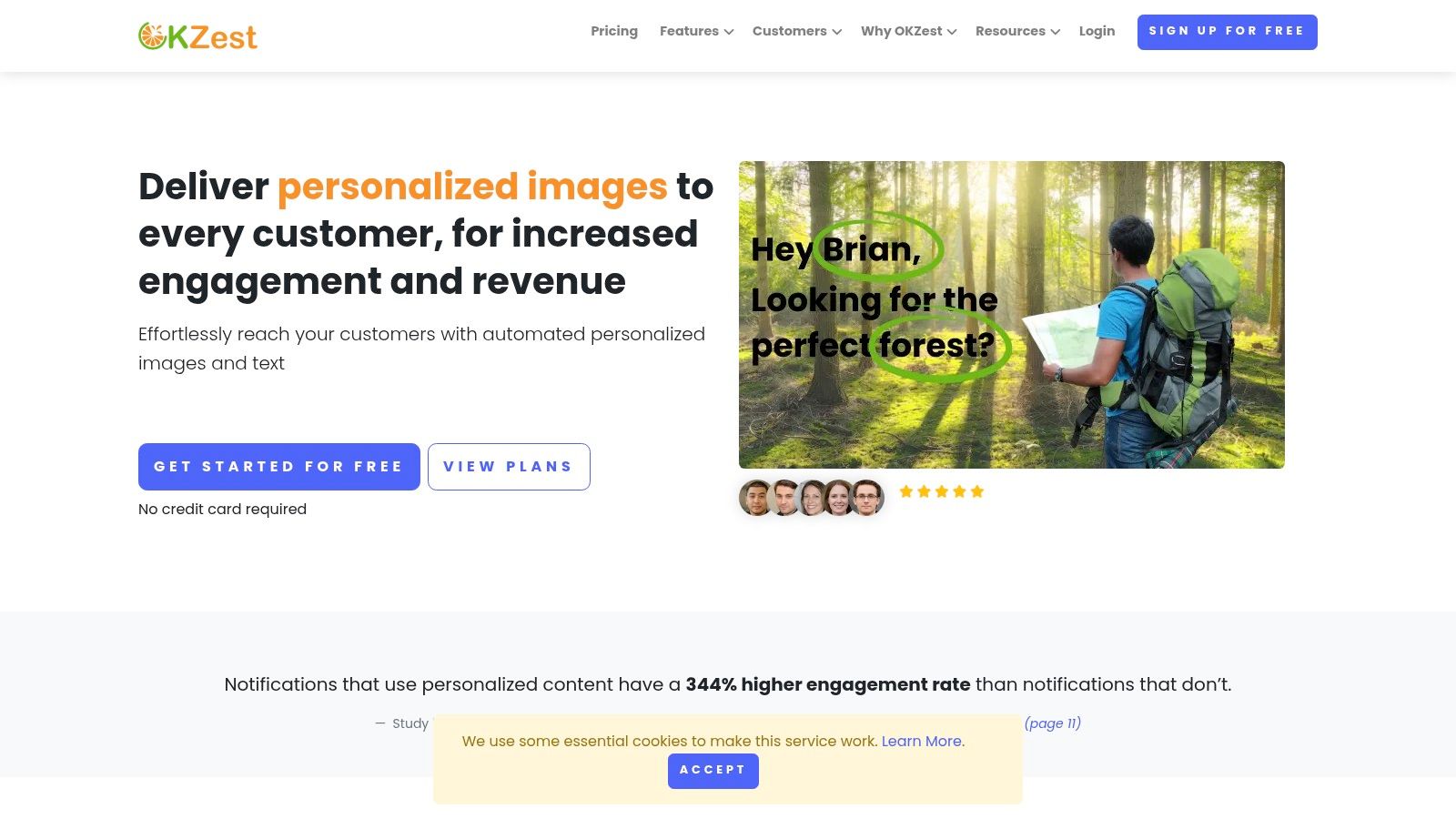
The platform stands out by making sophisticated visual personalization accessible to non-technical users. It seamlessly integrates with 99% of Email Service Providers (ESPs), including major players like Mailchimp and Klaviyo, allowing you to embed hyper-personalized images directly into email campaigns, newsletters, and even social media direct messages.
Strategic Analysis: The Power of Visual Personalization
OKZest's core strength lies in its ability to automate a traditionally complex marketing tactic. Instead of manually creating one-off designs, users can set up templates that dynamically pull data from various sources. This enables a level of personalization that resonates deeply with recipients, fostering a stronger connection and driving higher engagement rates.
Key Automation Capabilities:
- Dynamic Data Integration: Connect to static lists (like CSVs) or real-time data sources (like APIs and databases) to populate images with names, locations, birthdays, or specific purchase histories.
- Broad Channel Compatibility: Automate personalized visuals across email, websites, chatbots, and social DMs, ensuring a consistent and personalized brand experience.
- Fallback Logic: The system includes dynamic fallback options, so if a data point is missing (e.g., a first name), it can display a default value, preventing broken images and maintaining professionalism.
Strategic Takeaway: OKZest automates the creation of a unique asset for every single customer contact. This one-to-one visual communication is a powerful differentiator, proven to significantly boost click-through rates and overall campaign ROI by making each interaction feel personal and relevant.
Getting Started and Pricing
OKZest offers a user-friendly interface backed by responsive live chat and video support. The platform is built for collaboration, with higher-tier plans including project and role management features for marketing agencies and larger teams.
Its pricing structure is designed for scalability:
- Free Forever Plan: A generous free tier allows for up to 2,500 personalized image generations per month.
- Paid Tiers: Three additional paid plans scale up to enterprise-level volumes, offering advanced features and greater capacity.
This flexible model makes it an excellent tool for anyone from a solo consultant testing personalized campaigns to a large corporation implementing hyper-personalization at scale.
Explore its features at okzest.com.
2. HubSpot Marketing Hub
HubSpot Marketing Hub positions itself as an all-in-one platform where marketing automation is deeply connected to a native CRM. This integration is its core differentiator, allowing marketers to build sophisticated workflows based on a complete history of customer interactions, from initial website visits to sales calls and support tickets.
What truly makes HubSpot a premier destination for finding a real-world marketing automation example is its extensive educational ecosystem. The platform offers the Community Workflows Library, a collection of pre-built, vetted automation templates that users can clone directly into their accounts. This drastically reduces setup time for common scenarios like lead nurturing, re-engagement campaigns, and internal sales notifications.
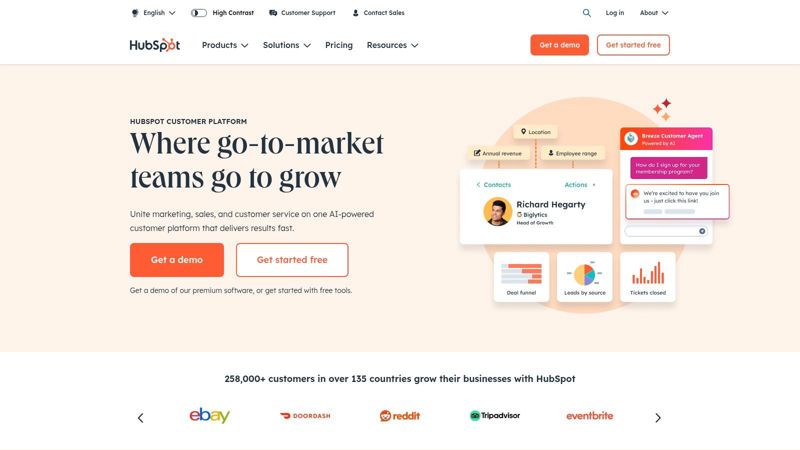
Strategic Breakdown & Key Features
HubSpot's visual workflow builder is intuitive, supporting if/then branching, personalization tokens from CRM data, and a wide array of triggers. For instance, a workflow can be initiated when a contact visits a specific pricing page but doesn't fill out a form, automatically enrolling them in a targeted follow-up sequence.
- Deep CRM Integration: Automations can trigger tasks for sales reps, update contact properties, or change a lead's lifecycle stage based on their behavior, ensuring seamless marketing-to-sales handoffs.
- Educational Resources: Beyond the platform, HubSpot Academy and its popular blog provide detailed guides and tutorials that break down complex automation strategies into replicable steps.
- Community-Sourced Examples: The Workflows Library allows users to see proven automation flows built by other HubSpot users, offering practical inspiration that goes beyond theoretical concepts.
Pricing and Accessibility
HubSpot offers a tiered pricing model that scales with the number of marketing contacts in your database. While a free plan with basic automation is available, more advanced features like branching logic are reserved for the Professional (starting at $800/month) and Enterprise tiers. A significant consideration is the mandatory onboarding fee required for these higher-level plans, which can be a substantial initial investment.
| Feature | Benefit |
|---|---|
| Visual Workflow Editor | Simplifies building complex, multi-path automation sequences without code. |
| Native CRM & Scoring | Enables hyper-targeted segmentation and alerts sales to high-intent leads. |
| Community Library | Provides cloneable, ready-to-use workflows to accelerate implementation. |
Website: https://hubspot.com
3. Mailchimp
Mailchimp is widely known for email marketing, but its Customer Journey Builder transforms it into a powerful platform for finding a practical marketing automation example. Its core strength lies in its simplicity and accessibility, providing users with dozens of pre-built journey templates that visualize common workflows like welcome series, abandoned cart reminders, and re-engagement campaigns.
What makes Mailchimp a standout for learning and implementation is its combination of a user-friendly interface with extensive, case-based educational resources. The platform doesn't just give you a blank canvas; it offers a library of proven templates and real-world success stories that detail the setup, logic, and performance results, making it easy for marketers to replicate effective strategies for their own businesses.
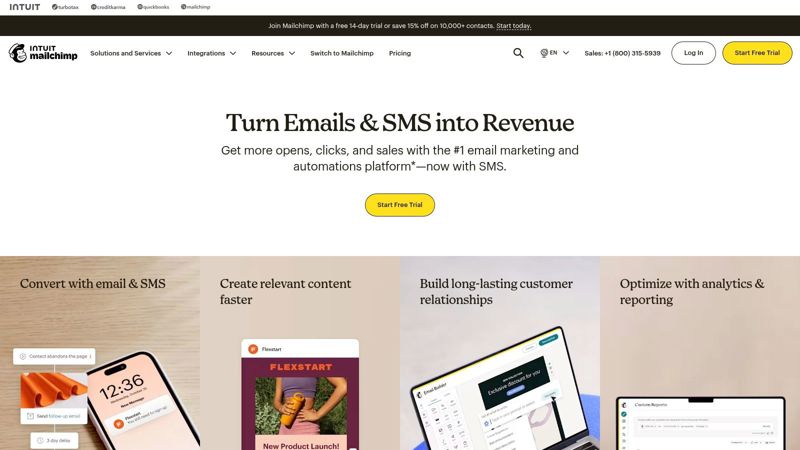
Strategic Breakdown & Key Features
Mailchimp’s visual journey builder allows for intuitive, drag-and-drop workflow creation with clear if/then branching, time delays, and tagging rules. A common use case is a post-purchase follow-up: a journey can be triggered by a specific product purchase, wait a set number of days, and then send a targeted email asking for a review or suggesting complementary products.
- Pre-built Customer Journeys: Offers a wide selection of templates for common goals like nurturing leads, re-engaging lapsed customers, and celebrating milestones, which significantly lowers the barrier to entry for new users.
- Strong Ecommerce Focus: The platform excels with deep integrations for Shopify, WooCommerce, and other e-commerce sites, enabling highly effective automations like abandoned cart recovery and product retargeting. Exploring these powerful Mailchimp integrations can unlock even more sophisticated workflow possibilities.
- Visual Performance Analytics: Each step in an automated journey provides clear analytics, allowing marketers to see exactly where subscribers are engaging or dropping off and optimize the workflow accordingly.
Pricing and Accessibility
Mailchimp’s pricing is tiered and primarily based on the number of contacts in your list. A free plan is available but offers very limited single-step automation. The Standard plan (starting at $20/month) unlocks the multi-step Customer Journey Builder and branching logic. As your contact list grows, costs can increase substantially, which is a key consideration for scaling businesses.
| Feature | Benefit |
|---|---|
| Pre-built Journey Templates | Accelerates setup and provides proven frameworks for common marketing goals. |
| Ecommerce Integrations | Enables high-ROI automations like abandoned cart and product recommendations. |
| Visual Journey Analytics | Offers clear, actionable insights to optimize workflow performance at each step. |
Website: https://mailchimp.com
4. ActiveCampaign
ActiveCampaign positions itself as a customer experience automation platform, with a strong emphasis on providing accessible and powerful marketing automation tools. Its core strength lies in a vast library of "automation recipes" - pre-built workflow templates that users can import directly into their accounts, dramatically lowering the barrier to entry for sophisticated automation.
What makes ActiveCampaign a go-to resource for finding a practical marketing automation example is its Marketplace. This hub contains hundreds of free and paid recipes created by both ActiveCampaign and its community of users. This "import and go" model allows marketers to quickly implement proven workflows for everything from welcome series and abandoned cart reminders to complex lead nurturing sequences, often complete with pre-written email content.
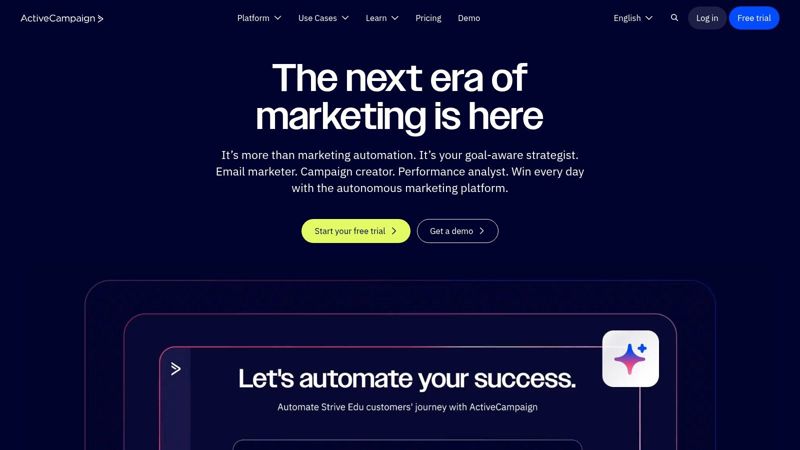
Strategic Breakdown & Key Features
ActiveCampaign’s automation builder is known for its flexibility, supporting a wide range of triggers, conditions, and actions. The platform’s unique value is how its recipe library demystifies this power. A user can find a recipe for a "Post-Purchase Upsell" sequence, import it, and immediately see the underlying logic, goals, and if/then branching used to make it effective.
- Importable Automation Recipes: The platform features hundreds of templates for specific use cases (like webinar follow-ups or re-engagement campaigns) that include both the workflow logic and email content.
- Community Marketplace: Users can browse and import automations created by other marketing professionals, often tailored to niche industries or specific software integrations, providing highly relevant examples.
- Educational Modules: Many popular recipes are accompanied by guides and videos explaining the strategy behind the automation and how to customize it for optimal performance.
Pricing and Accessibility
ActiveCampaign's pricing is tiered and primarily based on the number of contacts in your list. The Marketing Lite plan starts at $29/month, offering basic automation features. To access more advanced logic, conditional content, and lead scoring, users will need the Marketing Plus plan (starting at $49/month) or higher. While the importable recipes are a huge advantage, it's important to note that some advanced recipes may require features only available in higher-tier plans.
| Feature | Benefit |
|---|---|
| Automation Recipe Library | Enables rapid deployment of proven workflows without building from scratch. |
| Community Marketplace | Provides access to a wide variety of industry-specific automation examples. |
| Flexible Logic & Goals | Allows for building highly customized and goal-driven customer journeys. |
Website: https://www.activecampaign.com
5. Salesforce Marketing Cloud Engagement (Journey Builder)
Salesforce Marketing Cloud Engagement, particularly its Journey Builder tool, is an enterprise-grade platform designed for crafting sophisticated, multi-channel customer experiences. Its primary strength lies in its deep integration with the Salesforce CRM (Sales Cloud), enabling marketers to orchestrate complex automations based on a rich, unified view of customer data across sales, service, and marketing interactions.
What makes Journey Builder a valuable source for a real-world marketing automation example is its focus on guided learning through Salesforce's Trailhead platform. Instead of a simple cloneable library, it provides structured educational modules with hands-on challenges. These "Trails" walk users through building specific journeys, such as a welcome series, a re-engagement campaign, or an abandoned cart flow, ensuring users not only replicate but also understand the strategic logic behind each step.
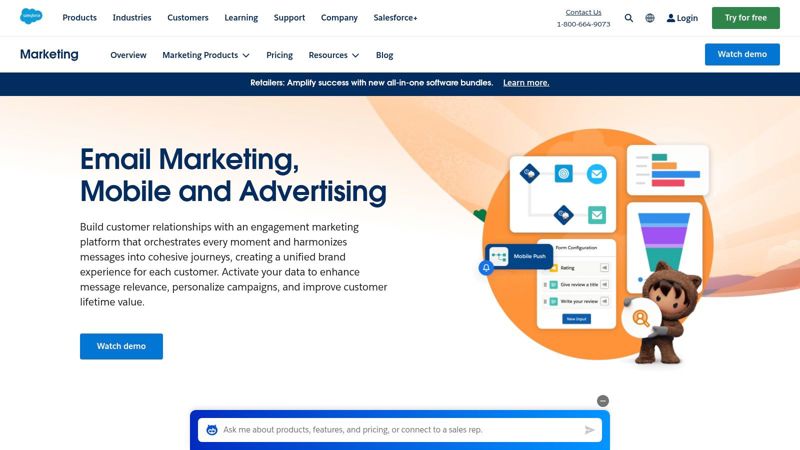
Strategic Breakdown & Key Features
Salesforce’s Journey Builder allows for sophisticated customer journey optimization by orchestrating touchpoints across email, SMS, push notifications, and even WhatsApp within a single visual canvas. For further insights into maximizing these paths, explore this guide on optimizing the customer journey. An example workflow could start with an email, use an A/B split to test messaging, and then send a follow-up SMS to non-openers after a set period, all while updating the contact record in the CRM.
- Multi-Channel Orchestration: Natively supports creating unified customer experiences across diverse channels like email, SMS, mobile push, and social ads, all from one interface.
- Guided Learning on Trailhead: Offers extensive, free learning modules that provide step-by-step instructions and practical examples for building common and advanced marketing journeys.
- Deep CRM Connectivity: Leverages the full power of Salesforce data to trigger journeys based on sales activities, service case updates, or any custom object change, aligning marketing with the entire business. Adhering to marketing automation best practices is crucial for leveraging this connectivity effectively.
Pricing and Accessibility
Salesforce offers transparent pricing for its core editions, though it's positioned at the higher end of the market, reflecting its enterprise focus. The Pro edition starts at $1,250/month, with more advanced features like A/B testing and predictive intelligence available in higher tiers such as Corporate and Enterprise. The platform's complexity often means it is best suited for larger teams with dedicated administrative support or an implementation partner.
| Feature | Benefit |
|---|---|
| Journey Builder Canvas | Visually maps and automates multi-channel customer journeys in one place. |
| Salesforce CRM Integration | Triggers automations based on comprehensive sales and service data for context. |
| Trailhead Learning Modules | Provides hands-on, guided education for building effective automation workflows. |
Website: https://www.salesforce.com/marketing/engagement/
6. Adobe Marketo Engage
Adobe Marketo Engage is a powerful, enterprise-level platform designed for complex B2B marketing motions. Its core strength lies in its ability to manage sophisticated, multi-channel customer journeys at scale, from initial lead acquisition through to long-term advocacy. The platform is especially useful for finding a robust marketing automation example because of its comprehensive Program Import Library.
This library provides marketers with pre-built, best-practice templates for common but complex programs like lead nurturing, webinar execution, lead scoring, and operational data management. Users can import these multi-step automation blueprints directly into their instance, significantly accelerating the setup process for proven marketing strategies.

Strategic Breakdown & Key Features
Marketo's automation capabilities are built for deep segmentation and precise journey orchestration. For example, a B2B marketer could use a program template to build a multi-stream nurture campaign that dynamically routes leads to different content paths based on their industry, job title, and real-time engagement with previous emails or website content.
- Program Import Library: Accelerates the deployment of complex B2B programs by providing battle-tested templates for everything from event marketing to advanced lead scoring.
- Enterprise-Grade Orchestration: Enables the creation of highly personalized, trigger-based customer journeys that adapt to behavior across multiple touchpoints, including email, web, and social.
- Advanced Analytics & Attribution: Offers deep insights into campaign performance and revenue attribution, allowing marketers to prove ROI and optimize strategies based on what drives results.
Pricing and Accessibility
Adobe does not publish public pricing for Marketo Engage; it operates on a contact-based licensing model that requires a custom quote from their sales team. This enterprise focus means it comes with a higher price point and a steeper learning curve than many SMB-focused tools. However, its scalability and advanced feature set are designed to meet the needs of large, data-driven marketing organizations.
| Feature | Benefit |
|---|---|
| Importable Program Templates | Drastically reduces setup time for complex B2B campaigns like webinars and nurtures. |
| Advanced Journey Logic | Allows for dynamic, real-time personalization of the customer journey at scale. |
| Revenue Attribution | Connects marketing activities directly to sales pipeline and revenue outcomes. |
Website: https://business.adobe.com/products/marketo.html
7. Klaviyo
Klaviyo has established itself as a dominant force in ecommerce marketing automation by focusing exclusively on the needs of online retailers. Its core strength lies in its deep integration with ecommerce platforms like Shopify and BigCommerce, allowing it to leverage rich customer data, including browsing history, purchase events, and product details, to power highly relevant automated messaging.
What makes Klaviyo an exceptional source for a real-world marketing automation example is its extensive "Flow Library." This isn't just a collection of templates; it's a strategic playbook of pre-built, goal-oriented automations specifically designed for ecommerce. Users can instantly implement proven flows for abandoned carts, browse abandonment, post-purchase follow-ups, and customer win-back campaigns, complete with step-by-step build guides.

Strategic Breakdown & Key Features
Klaviyo’s automation builder, known as "Flows," is triggered by specific ecommerce events. For example, a "Browse Abandonment" flow can start when a known user views a product but doesn't add it to their cart, sending them a reminder email with the exact product they viewed. This level of granularity is key to its effectiveness. By using this platform, you can learn more about how Klaviyo leverages customer data for personalization.
- Ecommerce-Centric Triggers: Automations are built around granular customer actions like "Viewed Product," "Added to Cart," and "Fulfilled Order," enabling precise and timely communication.
- Flow Library & Guides: Provides not just the templates but the strategic reasoning and setup instructions for high-ROI automations, significantly lowering the barrier to entry for sophisticated marketing.
- Integrated SMS Marketing: Allows for the seamless addition of SMS messages into any automation flow, with a transparent, credit-based pricing model that simplifies cost management.
Pricing and Accessibility
Klaviyo offers a free plan for up to 250 contacts and 500 email sends. Paid plans are flexible and scale based on the number of contacts and desired email/SMS volume. The Email plan starts at $20/month for 500 contacts, while the Email and SMS plan starts at $35/month for the same contact tier. The transparent, per-country credit costs for SMS are a major benefit for brands with international audiences, as it removes guesswork from budgeting.
| Feature | Benefit |
|---|---|
| Ecommerce Data Sync | Powers hyper-relevant automations using real-time product and order data. |
| Pre-built Flow Library | Enables rapid deployment of proven, revenue-driving ecommerce workflows. |
| Transparent SMS Pricing | Simplifies budgeting for multi-channel campaigns without hidden carrier fees. |
Website: https://www.klaviyo.com
Top 7 Marketing Automation Tools Comparison
| Product | 🔄 Implementation Complexity | ⚡ Resource Requirements | 📊 Expected Outcomes | 💡 Ideal Use Cases | ⭐ Key Advantages |
|---|---|---|---|---|---|
| OKZest | Moderate learning curve for API and data integration | No-code platform; minimal technical resources; robust API | High engagement via personalized dynamic images | Email marketers, agencies, coaches, nonprofits needing scalable image personalization | Easy per-recipient image personalization; broad ESP support; team collaboration |
| HubSpot Marketing Hub | Medium; visual workflows with CRM integration | CRM and marketing database needed; onboarding fees apply | Improved lead management and segmentation; marketing automation | Businesses leveraging CRM for segmented marketing and internal alerts | Large workflow library; strong CRM integration; extensive training resources |
| Mailchimp | Low to medium; starter templates easy, advanced features in higher plans | Basic to moderate; dependent on contact volume and tier | Increased automation adoption; visual campaign analytics | Small to mid-sized businesses needing easy-to-start email automation | Pre-built journeys; strong documentation; visual analytics |
| ActiveCampaign | Low to medium; fast setup via importable recipes | Moderate depending on plan; monitoring of send limits needed | Quick deployment of diverse automation sequences | Users seeking rapid automation setup across multiple use cases | Importable automation recipes; broad template marketplace; education modules |
| Salesforce Marketing Cloud Engagement (Journey Builder) | High; complex enterprise setup requiring admin support | High; enterprise-grade system with multi-channel support | Advanced, multi-channel orchestration; detailed journey versioning | Enterprises needing robust, multi-channel marketing orchestration | Deep CRM connectivity; multi-channel engagement; guided learning via Trailhead |
| Adobe Marketo Engage | High; steep learning curve for complex B2B setups | High; contact-based licensing, advanced resources required | Scalable enterprise journeys with detailed analytics | Large B2B enterprises requiring sophisticated journey orchestration | Best-practice program templates; scalability; advanced analytics |
| Klaviyo | Low to medium; ecommerce-focused with guided build flows | Moderate; tailored for ecommerce with SMS credit costs | Revenue-driving ecommerce automations with transparent pricing | Ecommerce businesses needing proven cart and post-purchase flows | Ecommerce-centric triggers; clear SMS pricing; quick deployment |
Final Thoughts
We've journeyed through a diverse landscape of marketing automation examples, from HubSpot’s comprehensive lead nurturing to Klaviyo’s precision-engineered e-commerce flows. The core lesson is clear: automation is not about replacing human connection but amplifying it at scale. Each marketing automation example we explored showcases a unique strategy, but they all share a common foundation of delivering the right message to the right person at the right time.
By deconstructing the workflows of tools like ActiveCampaign and Salesforce, we see how intricate customer journeys can be mapped and executed flawlessly. The success of these strategies hinges on understanding customer behavior, segmenting audiences with precision, and continuously testing every element of the campaign.
Key Takeaways and Actionable Next Steps
To translate these examples into your own success, focus on these foundational principles:
- Start with the "Why": Before you build any workflow, define its purpose. Are you nurturing new leads, re-engaging lapsed customers, or driving upsells? A clear objective is your most critical asset.
- Data is Your Foundation: The sophistication of your automation is directly tied to the quality of your data. Prioritize collecting clean, relevant data points through forms, website tracking, and integrations.
- Segment, Then Personalize: Generic automation feels robotic. Use the data you collect to create meaningful audience segments. This allows for hyper-personalized content that resonates deeply, as demonstrated by the advanced segmentation in Marketo Engage.
- Iterate and Optimize: Your first workflow will not be your last. Treat every automated campaign as a living project. Monitor performance, analyze results, and make data-driven adjustments to improve engagement and conversion rates over time.
Choosing Your Automation Partner
Selecting the right tool is a pivotal decision. Your choice should align directly with your business model, technical resources, and strategic goals.
- For B2B businesses focused on a long sales cycle, platforms like HubSpot or Salesforce Marketing Cloud Engagement offer the robust CRM integration and lead scoring necessary for success.
- E-commerce brands will find immense value in Klaviyo or Mailchimp, which provide deep integrations with platforms like Shopify and specialized features for abandoned cart recovery and product recommendations.
- For those needing a balance of power and user-friendliness, ActiveCampaign offers a versatile solution that scales from small businesses to enterprise teams.
Beyond the core platforms, specialized automation exists for niche verticals. For instance, managing a network of partners requires a dedicated approach, and understanding the principles of affiliate marketing automation can provide a significant competitive edge in that space. Ultimately, the best marketing automation example is the one you build, test, and perfect for your unique audience. Let these case studies be your blueprint, not your boundary.
Ready to put these examples into practice with a tool designed for clarity and impact? See how OKZest simplifies complex automation, helping you build powerful, personalized customer journeys without the steep learning curve. Get started with OKZest today!